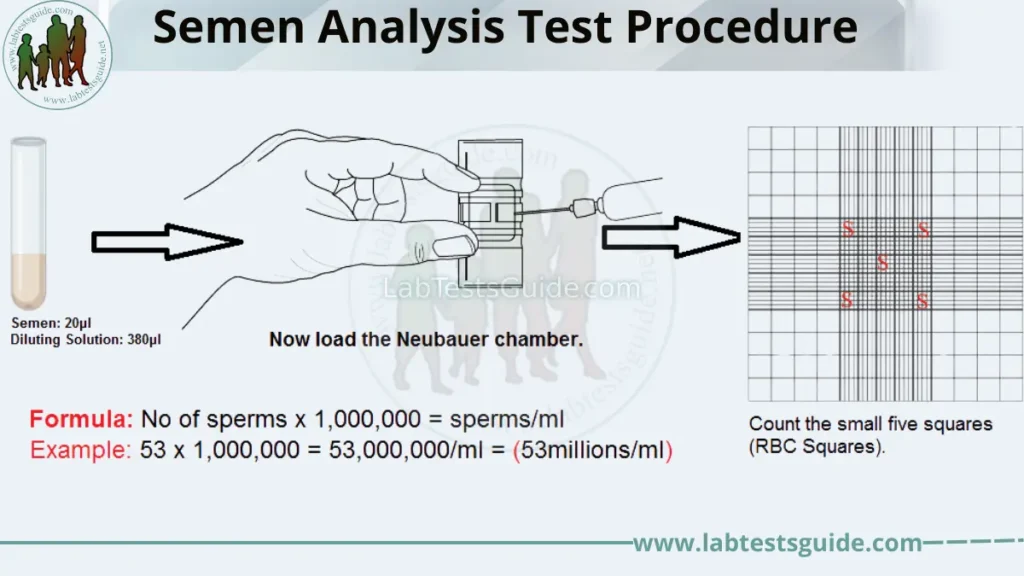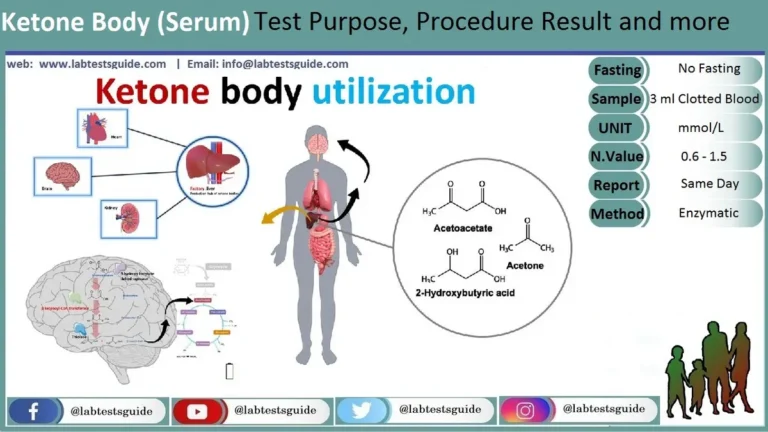Semen Analysis Test procedure in witch Physically Examination of semen and Counting of Sperms on neubauer Counting chamber and count motility, total sperms count, morphology, viality and more. Semen analysis is a test of a man’s sperm and semen. Also known as a sperm count or male fertility test, its results show how many sperm are released, as well as how they’re shaped and how well they move.

Preparation for the Semen Analysis Test:
Your doctor will tell you what to do in preparation for semen analysis. It is very important to follow these instructions to obtain accurate results.
To get the best sample:
- Avoid ejaculation for 24 to 72 hours before the test.
- Avoid alcohol, caffeine, and drugs like cocaine and marijuana for two to five days before the test.
- Stop taking any herbal medications, such as St. John’s wort and echinacea, as directed by your health care provider.
- Avoid any hormonal medication as instructed by your health care provider.
How to Conduct Semen Sample:
There are four main ways to collect a semen sample:
- Masturbation
- Sex with a Condom
- Sex with withdrawal before ejaculation
- Ejaculation stimulated by electricity
Two main factors are crucial to having a good test sample.
1. The semen must be kept at body temperature (37oC).
2. The semen must be delivered to the testing center within 30 minutes of leaving the body.
Precautions for Semen Sample
- Don’t use condoms, particularly with spermicide.
- The specimen should be maintained at 37 °C during transport if brought from home and examined within 3 hours of collection.
- A sterile container is needed, and the sample should be collected at room temperature of 37 °C.
- Plastic containers are not recommended.
- Avoid extreme temperatures.
- The analysis should be done immediately when the semen is liquefied.
- Should be examined within 4 hours,
- The sample should be kept at 37 °C.
- Wait till liquefaction is complete for the examination.
- Drugs that may decrease the count are:
- Antineoplastic agents (nitrogen mustard, procarbazine, vincristine, and methotrexate).
- Direct the patient to avoid alcohol intake for several days before the semen collection.
- Instruct the patient to avoid sexual activity for 2 to 3 days before collecting the sample.
- Avoid prolonged abstinence because the quality of the sperm and their motility may be decreased.
Semen Analysis Test Procedure:
- Volume: Measure the Volume of Semen
- Color: Check the semen Color it should be whitish to gray and opalescent.
- Liquefaction time is normally 10 to 30 minutes at 37 °C.
- Viscosity: measures the seminal fluid’s resistance to flow (Thick or Thin).
- pH: Measure the pH of semen it should be from 7.2 to 7.8.
- Total Sperm Count: Count the Total Sperms with Neubauer Counting Chamber or Makler Counting Chamber
- Motility: Count the Motile and Non Motile Sperms in 5 microscopic Fields and calculate
- Viability: Count the Viability Sperms with vital stain (trypan blue).
Total Sperm Count :
Option 1:
Sperm count solution:
- Formalin = 1 mL
- Sodium bicarbonate = 5 grams
- Distal water = 100 mL
- Mix well the above ingredients.
- Add all the above ingredients into 100 mL distal water and mix it.
Procedure:
- Take 0.02ml (20μl) of semen
- Take 0.38ml (380μl) above solution (diluting fluid). (Ratio: 1:19)
- Mix well above semen and Semen Diluting Solution (see above).
- Now load the Neubauer chamber.
- Count the large two squares (WBC Squares).
- Important that move the microscope up and down to count the sperm at a different levels.
- Calculation: Count in the large two square x100,000 = count in million /mL.

Option 2:
- Dilute the semen with water or above Semen Diluting solution.
- Take 1:20 dilution of the semen.
- Count the five RBC counting squares (4 at the corner and one at the center).
- Calculations: suppose the sperms are 50 in all these 5 RBC squares.
- 50 x 1,000,000 = 50,000,000/mL (50million/mL).

Count The Sperm Motility:
Count at least 200 motile or non-motile sperms in 5 different microscopic fields. % of the nonmotile sperm are calculated as follows:

Sperm Viability:
The sperm ejaculated in the semen remain viable for several days in the female genital tract. Fertilization can occur while the sperm are alive, and they can survive for 5 days. Sperm can be preserved for decades when semen is frozen at -20°C.
Sperm viability is necessary when progressively motile sperm are less numerous.
Method to assess feasibility:
- Take a drop of semen on Slide.
- Add an equal volume of vital stain (trypan blue).
- Cover with the coverslip.
- Hold for a few minutes, but not more than 5 minutes.
- Count 100 cells, including viable sperm (not stained) and dead sperm (take the stain). See Below
- This will give you the viable sperm count.

What do the results mean?
- Volume is the amount of semen in your sample. The normal volume of semen is 2 ml to 3 ml. A low volume can cause infertility.
- Liquefaction: It should take 15 to 30 minutes before the semen liquefies. Although semen is initially thick, its ability to liquefy or become a watery consistency helps sperm to move. If the semen does not liquefy in 15 to 30 minutes, fertility could be affected.
- Sperm count is the number of sperm in the entire sample. A normal semen analysis should be between 20million/ml to over 200million/ml. A low count can make it difficult for your partner to get pregnant.
- Sperm movement (motility) tells you the percentage of sperm moving forward. The sperm must be able to move forward to fertilize an egg.A normal result, more than 50% of sperm must move normally an hour after ejaculation.
- Sperm shape (morphology) is the number of sperm that have a normal shape. Normal semen will have at least 50% normally shaped sperm. Abnormally shaped sperm may not be able to fertilize an egg.
- The pH describes the acidity of your semen. A pH level should be between 7.2 and 7.8 to achieve a normal result. Abnormal acidity can kill sperm or affect their ability to move.
- White blood cells (leukocytes) in sperm can be a sign that an infection is affecting your fertility. No any White Blood Cell in Normal Semen.
- Appearance should be whitish to gray and opalescent. Semen that has a reddish-brown tinge could indicate the presence of blood, while a yellow tinge could indicate jaundice or be a side effect of medication.
If the results of your semen analysis are not all normal, it does not mean that you are permanently infertile. But it does show that your sperm may be part of the problem you and your partner have getting pregnant.
Your provider may order more tests to help find the cause of the problem so it can be treated. There are many possible causes, including:
- Certain habits you can change, such as smoking
- A physical problem in the testicles, such as an enlarged vein (varicocele)
- Certain genetic disorders or other health conditions, including hormonal disorders, diabetes, and cystic fibrosis
Treatments for infertility depend on the cause. To help improve your chances of having a baby, your provider may refer you to a doctor who specializes in infertility.
Semen Analysis Test – Normal Values Chart:
| Parameter | Description | Referance Ranges |
|---|---|---|
| Semen Volume | Total amount of fluid ejaculated | 2ml to 3ml |
| Sperm Count | The total number of sperm in the measured volume of ejaculate | >= 20 million/ml |
| Total Sperm Number | Total number of sperm in the ejaculate | >= 39 million |
| Sperm Motility | Number of motile sperm compared to non-motile sperms and is reported as Percentage. | Total motility >= 40% motile sperms within 60 minutes of ejaculation. Progressive motility >= 32% |
| Sperm Viability Or Vitality | The number of sperms in the sample that are alive as a percentage of the total number of sperms | >= 58% |
| Sperm Morphology | Number of ideally shaped sperms as compared to imperfectly shaped sperms and reported as a percentage of the total number of sperms | >= 4% |
| White Blood Cells | A large number of WBC can be a sign of infection in the reproductive tract | < 1 million/ml |
| Semen pH | Measured to test if the semen is acidic or alkaline. | 7.2 – 7.8 |
| Sperm Antibodies | Normally done in specialised laboratories using methods approved by WHO | <= 50% motile sperm Showing antibody activity |
What do abnormal results mean?
Abnormal sperm will have trouble reaching and penetrating eggs, making conception difficult. Abnormal results could indicate the following:
- infertility
- infection
- hormonal imbalance
- disease, such as diabetes
- gene defects
- exposure to radiation
If your results come back at abnormal levels, your doctor will probably suggest that you take additional tests. These tests include:
- genetic tests
- hormone testing
- urinalysis after ejaculation
- taking a tissue sample from your testicles
- anti-sperm immune cells testing
Abnormal Results Table:
| Abnormalities | Descriptions |
|---|---|
| Aspermia | Absence of semen |
| Azoospermia | Absence of sperm in the semen |
| Hypospermia | Low semen volume |
| Hyperspermia | High semen volume |
| Oligozoospermia | Very low sperm count |
| Polyzoospermia | Abnormally high sperm count in the ejaculate |
| Asthenozoospermia | Poor sperm motility |
| Teratozoospermia | Sperms that have morphological defects |
| Necrozoospermia | All sperms in the ejaculate are dead |
| Leucospermia | A high level of white blood cell present in the semen |
| Hematospermia | Presence of red blood cells in the ejaculate |
Factors that can influence a semen analysis report
- Incorrect semen collection techniques, if the normal semen analysis report sample is not collected correctly or the container is not sterile.
- The delay time between the supply of the sample and the analysis of the sample in the laboratory.
- Too short an interval from the previous ejaculation.
- Recent illness in the last 3 months (even the flu or fever can temporarily lower sperm count).
- Physical damage to the testicles can lead to low sperm count or a man who has had radiation treatment to the testicles or has been exposed to certain medications has low sperm count. Failure of the testicles, obstruction of the ducts that carry semen can affect sperm count.
Normal and Abnormal Semen Table:
| Parameters | Normal Semen | Abnormal Semen |
|---|---|---|
| Volume | 2 to 4 mL | <2 or >4 mL |
| Color | grey to white (Opalescent) | Brown to red |
| Sperm density (count) | >2o million/mL | <20 million/mL |
| Total sperm count | 20 to 250 million/mL | <20 million/mL |
| Motility | Active motile 60 to 80%>50% forward progression >25% rapid progression (within 60 min) | <50% after 2 hours |
| Motility score (evaluated 2 to 4 hours after ejaculation) Motility is graded as:0= none 1= poor 2= moderate 3= good 4= excellent | 3 to 4 | 0 to 1 |
| Liquefaction | Immediate (within 10 to 30 min) | >60 min |
| pH | 7.2 to 7.8 | <7.2 |
| Viability | >65% do not take stain and are alive | % of dead cells is more (than 65%) and take stains |
| Morphology | >70% normal <4% immature form | >30% abnormal form |
| Immature form | <4 % | >4 % |
| Defective heads | <35 % | >60 % |
| Defective tails | <20 % | >25 % |
| WBC count | 0 to 2000/mL | Increased number |
| The aggregate of >10 sperms | Absent | Seen in prostatitis |
| Fructose | 150 to 600 mg/dL | Decreased level/absent |
Abnormal Results Chart:
| Abnormalities | Descriptions |
|---|---|
| Aspermia | Absence of semen |
| Azoospermia | Absence of sperm in the semen |
| Hypospermia | Low semen volume |
| Hyperspermia | High semen volume |
| Oligozoospermia | Very low sperm count |
| Polyzoospermia | Abnormally high sperm count in the ejaculate |
| Asthenozoospermia | Poor sperm motility |
| Teratozoospermia | Sperms that have morphological defects |
| Necrozoospermia | All sperms in the ejaculate are dead |
| Leucospermia | A high level of white blood cell present in the semen |
| Hematospermia | Presence of red blood cells in the ejaculate |
FAQs:
What is a semen analysis?
A semen analysis is a laboratory test that measures various parameters of semen, including the number, shape, and movement of sperm. It is an important diagnostic tool for assessing male fertility.
How long does it take to get the results of a semen analysis?
The results of a semen analysis usually take 1-2 days to be processed and interpreted.
Is a semen analysis painful?
No, a semen analysis is not painful. The patient collects the sample by masturbation, which may be uncomfortable for some men, but it should not be painful.
Can I collect the semen sample at home?
Yes, some laboratories allow patients to collect the semen sample at home and bring it to the laboratory for analysis. However, the sample should be delivered to the laboratory within one hour of collection to ensure accurate results.
Do I need to fast or prepare for a semen analysis?
No, there is no need to fast or prepare for a semen analysis. However, the patient should refrain from ejaculation for 2-5 days before the test to ensure an adequate sample.
Can I have sex before a semen analysis?
No, the patient should refrain from ejaculation for 2-5 days before the test to ensure an adequate sample.
How much semen is required for a semen analysis?
The laboratory usually requires a minimum of 1-2 milliliters of semen for analysis.
Can I use a condom to collect the semen sample?
No, a condom should not be used to collect the semen sample as it may contain spermicidal agents that can affect the results of the test.
Can I use lubricants to collect the semen sample?
No, lubricants should not be used to collect the semen sample as they may contain substances that can affect the results of the test.
Can medications or supplements affect the results of a semen analysis?
Yes, certain medications and supplements can affect the results of a semen analysis. It is important to inform the healthcare provider of any medications or supplements that are being taken before the test.
Can smoking or alcohol consumption affect the results of a semen analysis?
Yes, smoking and alcohol consumption can affect the results of a semen analysis. It is important to inform the healthcare provider of any relevant lifestyle habits before the test.
What is considered a normal sperm count?
A normal sperm count is usually between 15 million and 200 million sperm per milliliter of semen.
Can a semen analysis diagnose infertility?
A semen analysis can provide important information about male fertility, but it is not a definitive diagnosis of infertility. Other tests may be needed to determine the cause of infertility.
Home | Blog | About Us | Contact Us | Disclaimer
Possible References Used








Thank you so much for this site.
And this topic too.
I have learned so much.
God bless you.